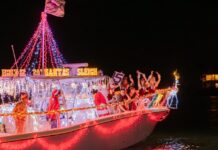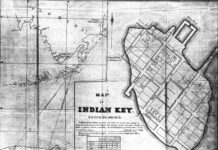
Fiesta Key connects to the Overseas Highway near MM 70. The island has been called a name or two, which is nothing unusual in the Florida Keys.
One of the earliest names on record is Jewfish Kay. In an 1873 survey, Charles Smith, who came to the Keys to conduct government surveys of the islands, identified it as Jewfish Key.
The island’s first legal owner appears to be Louie Turner, who was granted a homestead (or qualified for a homestead claim) on Jan. 7, 1908. Not having seen the property deed, it is supposed that the island was identified as Jewfish Key — though it would not remain the name for long.
By the early 1930s, the island was being identified by the slightly different Jewfish Bush Key. In 1934, World War I veterans were brought to the Keys to build a series of concrete automobile bridges between Lower Matecumbe and No Name Keys. The bridges would replace the automobile ferries navigating the highway’s water gaps between the Upper and Lower Keys. The first bridge project would have connected Lower Matecumbe Key to Jewfish Bush Key.
The intervening 1935 Labor Day Hurricane ended that plan, and the only evidence of their work is eight concrete bridge piers out in the water (and visible from the Channel 2 Bridge). The eye of the Category 5 hurricane, the most powerful storm to date to strike North America, crossed over Jewfish Bush Key.
In the years after the hurricane, Leon E. Goetz began developing the island and calling it Goetz Key. In 1938, when a new and improved Overseas Highway opened, the island became directly connected to the mainland. It is probably not coincidental that, according to a July 30, 1939, article in the Miami News, Goetz spent $15,000 improving the island by clearing land and building a harbor, dock and a dwelling.
It is also probably not surprising that, not so long after, in 1941, the Miami Herald began advertising the island, identified as Goetz Key — Tropical Island (noted as Jewfish Key on charts), for sale. The $25,000 price included the 30-acre island with a connecting causeway to the Overseas Highway, a two-story concrete coral-rock house, servants’ quarters, a deep water harbor, an airfield and a private beach.
In the same general time, it seems, the distinctive coral-rock house, as well as the rest of the property, was abandoned — and abandoned for several years as woody vines wrapped around the house. They were cleared circa 1942. The island, and its structures, it can be imagined, having also been ignored (the airfield, beach and servants’ quarters), had also been overrun by weeds, bushes and other naturally occurring vegetation (and the critters they attracted).
Circa 1946, the island was sold to the Greyhound Corporation, which planned to build a bus terminal and so much more on the island. Greyhound’s goal was not just to bring them to the island for a bite to eat at a bus stop but to make the island a destination, a “tropical” getaway. The architect for the project was John Allen King.
An Islamorada general contractor named Alonzo Cothron was hired to construct the architect’s plans. Cothron built a bus terminal and a restaurant capable of seating 125 people. He also made five red-roofed buildings; each contained four hotel guest rooms. When the job was completed, Cothron stated that it was “the handsomest development of its kind anywhere in the U.S.”
It was not long before the island was called Greyhound Key — because it was where the Greyhound Bus Station was located. By 1950, national newspapers were advertising the island as Greyhound Tropical Key. The facility was called the Post House Hotel and Restaurant. Dewey Jinnette had been hired to be the manager circa 1948. In addition to the accommodations, the little island resort offered skiff rentals, chartered fishing trips and shuffleboard. When Greyhound Key (and really, the bus station) became home to a post office on Nov. 1, 1955, Jinnette was named postmaster. The postal designation was issued to Greyhound Key, Florida, at which point the island became officially known as Greyhound Key — at least for a while.
Goetz’s distinctive coral rock building became home to Jinnette and his young family, who spent 11 years living on the island. The children, Sally and Joe, were bused 20 miles to the Coral Shores School on Plantation Key. For several years, Sally and Joe traveled to and from school on Greyhound buses. After the tolls for the Overseas Highway were lifted for the local population, the Monroe County school bus would travel south to Greyhound Key to pick up the Jinnettes and the children who traveled up from the Marathon area to attend classes at the Plantation Key School.
When Sally graduated from the school in 1953, she was one of 13 students in its inaugural graduating class. Joe became friends with Terry Starck, who grew up on Lower Matecumbe Key, on the property that is home to the world-famous Robbie’s Marina. The two began riding the bus together to school when Joe was in the second grade. They are still best friends.
All good things and, in this case, all good names (or at least some of them) sometimes come to an end. For Greyhound Key, the Greyhound Corporation sold the island to The Kampgrounds of America in 1966. KOA Kampgrounds changed the name to Fiesta Key (because if you are going to go camping in the Florida Keys, it should be a party). Though no longer owned by KOA, the island remains Fiesta Key today.























